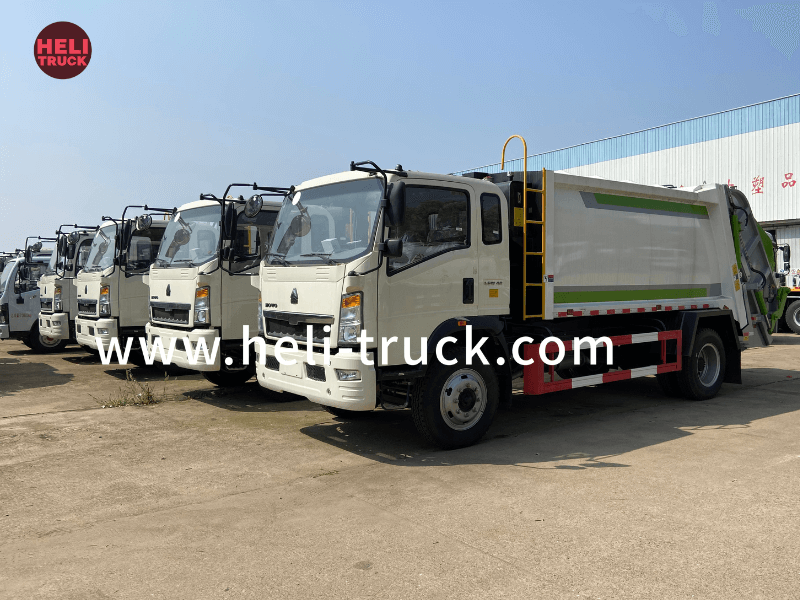Understanding Garbage Compactor Truck Dimensions A Comprehensive Guide

Introduction
Garbage compactor trucks play a crucial role in waste management systems, helping to collect and compact waste efficiently. One of the key factors that determine the effectiveness and capacity of these trucks is their dimensions. In this article, we will explore the various dimensions of garbage compactor trucks, including length, width, height, and capacity. Understanding these dimensions is essential for ensuring that the right truck is selected for the job and that it can navigate through urban environments effectively.
Garbage Compactor Truck Dimensions
Garbage compactor trucks come in various sizes and configurations to suit different waste collection needs. The dimensions of these trucks can vary depending on factors such as the type of waste being collected, the volume of waste generated, and the specific requirements of the job. Let's explore the key dimensions of garbage compactor trucks:
1. Length
The length of a garbage compactor truck is an important dimension that determines its overall size and capacity. Typically, the length of these trucks can range from 20 feet to 30 feet, with larger trucks measuring up to 40 feet in length. The length of the truck is important for determining its maneuverability and storage capacity. Longer trucks may have a higher waste collection capacity but could face challenges navigating narrow streets and tight spaces in urban areas.

2. Width
The width of a garbage compactor truck is another crucial dimension that impacts its maneuverability and efficiency. The width of these trucks typically ranges from 7 feet to 9 feet, with some larger models exceeding 10 feet in width. The width of the truck is essential for determining its ability to access narrow alleys and streets for waste collection. A narrower truck may be more suitable for urban environments with limited space, while wider trucks may offer higher capacity but face restrictions in certain areas.
3. Height
The height of a garbage compactor truck is an important dimension that determines its clearance and accessibility. The height of these trucks can vary from 10 feet to 12 feet, with some models reaching heights of up to 15 feet. The height of the truck is crucial for ensuring that it can pass under bridges, power lines, and other overhead obstructions during waste collection routes. Additionally, the height of the truck impacts its stability and center of gravity, affecting its overall safety and performance.
4. Capacity
One of the most critical dimensions of a garbage compactor truck is its waste collection capacity. The capacity of these trucks can vary widely, with smaller trucks typically holding around 5 to 10 cubic yards of waste, while larger trucks can have capacities exceeding 30 cubic yards. The capacity of the truck is determined by factors such as the size of the compactor unit, the type of waste being collected, and the frequency of waste collection routes. Choosing a truck with the right capacity is essential for maximizing efficiency and reducing the need for frequent trips to disposal sites.
Factors Affecting Garbage Compactor Truck Dimensions
Several factors can influence the dimensions of garbage compactor trucks and the selection process for choosing the right truck for a specific waste management task. Some of the key factors that affect these dimensions include:
1. Type of Waste
The type of waste being collected is a significant factor that influences the dimensions of a garbage compactor truck. Different types of waste, such as household waste, industrial waste, or construction debris, may require specific truck configurations to accommodate their unique properties. For example, trucks collecting bulky waste may need larger storage capacities, while trucks collecting hazardous materials may require specialized containment systems.
2. Waste Volume
The volume of waste generated in a specific area or during a specific time period can impact the dimensions of the garbage compactor truck needed for the job. Areas with high waste generation rates may require larger trucks with higher capacities to handle the volume efficiently. Conversely, smaller trucks may be suitable for areas with lower waste volumes to avoid unnecessary costs and resources.
3. Operational Requirements
The operational requirements of a waste management system, such as the frequency of waste collection routes, the distance to disposal sites, and the terrain of the collection area, can influence the dimensions of the garbage compactor truck. Trucks operating in urban environments with tight spaces may need to be compact and maneuverable, while trucks servicing rural areas with rough terrain may require larger trucks with off-road capabilities.
4. Regulatory Compliance
Regulatory requirements and standards for waste collection and disposal can also impact the dimensions of garbage compactor trucks. Trucks must comply with regulations regarding vehicle size, weight limits, and safety standards to operate legally and safely. Ensuring that a garbage compactor truck meets all regulatory requirements is essential for avoiding fines, penalties, and disruptions to waste management operations.
https://www.heli-truck.com/ultimate-guide-to-truck-mounted-cranes-types-uses-and-future-trends/ are essential vehicles in waste management systems, helping to collect, transport, and compact waste efficiently. Understanding the dimensions of these trucks is crucial for selecting the right vehicle for the job and ensuring that it can navigate through urban environments effectively. By considering factors such as length, width, height, and capacity, waste management professionals can make informed decisions when choosing garbage compactor trucks for their operations. Choosing the right truck with the appropriate dimensions is key to optimizing waste collection processes, reducing costs, and promoting environmental sustainability.
